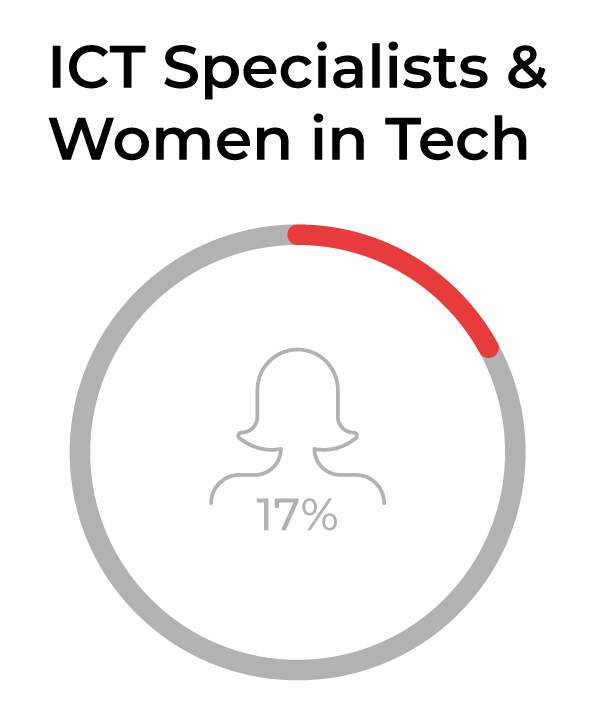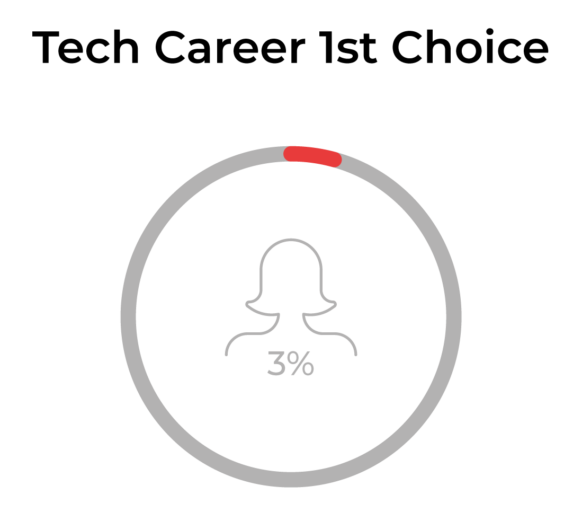
The debate regarding gender and diversity issues is long overdue, and the Women in Technology variable, although newer and not yet fully explored, is beginning to present some of the most alarming statistics.Before taking any kind of action, whether that’s closing the tab with this article or scrolling down with the intention of merely scanning the information, you are encouraged to ask yourself a couple of questions:How many women work with you?Is your company innovative?The answer to the first question will be inexorably linked to the answer to the second. This is because innovation comes from understanding that diversity brings the opportunity for the new, for the disruptive.And judging by the statistics, we have a long way to go.
Statistics on Women in Technology
In Argentina, according to data provided by Women in Technology, only 16 percent of the people who enroll in degrees related to the Tech world are women.At the employment level, 14 percent of technical roles are filled by a woman and only 4 percent of startups were founded by women.Of these total technical roles, only 1.6 percent hold a managerial position, according to the Harvard Business Review.
On a global scale:
Today, women represent 40 percent of the workforce worldwide, but of this total only 17 percent do so in the area of technology, according to data from Women in Technology and the World Bank.Because of this, and in line with the global scale of the problem, Women in Technology earn 19 percent less than men who do the same job. And as if that statistic was not disturbing enough, 46 percent of Women in Technology have suffered discrimination at some point in their professional careers.


Another piece of information that should be alarming not only to the technological ecosystem but also to entrepreneurs is that 93 percent of the capital invested in companies comes from male investors.The figures for Argentina and globally make for uncomfortable reading. But what is behind the Women in Technology gap?
Behind the statistics
The problem of inequality in the world of work has its roots in the classroom. That is where the academic story of many girls begins, but this space which seems so innocent is where the wage gap, the labor gap, and the low rate of enrollment in technology-related degrees is born. It is where we can see the underlying reasons for the statistics on Women in Technology.

First of all, some factors which affect the problem must be taken into account:
- Childhood games
- Perceptions regarding subjects that are seen as more “male” versus subjects that are viewed as being “for females”
- Incentives and definitions of happiness
- The influence of teachers and parents
- The media
If we dove even deeper we would find more and more of these factors, but for now we can identify these items as generally “responsible” for the statistics on Women in Technology .Now, to respond to these statistics, some other really interesting statistics that provide context to the variables, and of course to the problem, must be considered:
16 percent of Women in Technology say that a teacher suggested that they study a degree related to the IT world versus 33 percent of men who say that a teacher recommended the tech world as a profession.
And the most revealing data of all:
Over a quarter of female students said they had been put off of a career in technology because it’s too male dominated.
Increasing the number of Women in Technology
Understanding the complexity of the problem and knowing that we want more and more diversity in the tech environment, at Santex we decided to implement a new referral policy during 2020.Our Community already had a Referral Policy to incorporate more and more people in our Operations area. The reward for recommending someone was $900 (USD). Today we have decided that we want our teams to be made up of more women, so those who refer a potential new collaborator will be given an incentive of $1,800 (USD) if their referral leads to a woman being hired.This new policy accompanies other decisions we have made at the company level to be more inclusive every day, such as:
- We have a nursery so that mothers and fathers have a space to leave their children while they go back to work after their maternity/paternity leave
- We offer paternity leave for those who have recently become fathers, because we understand that the task of caring for newborns has to be shared
- About 50 percent of our areas are led by women
- The influence of teachers and parents
- We have a special channel for anonymous complaints in the event of problematic situations inside or outside the company.
- At Santex we have reviewed and modified salaries to achieve equality between men and women performing similar roles.
At Santex we have reviewed and modified salaries to achieve equality between men and women performing similar roles.





